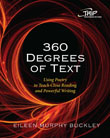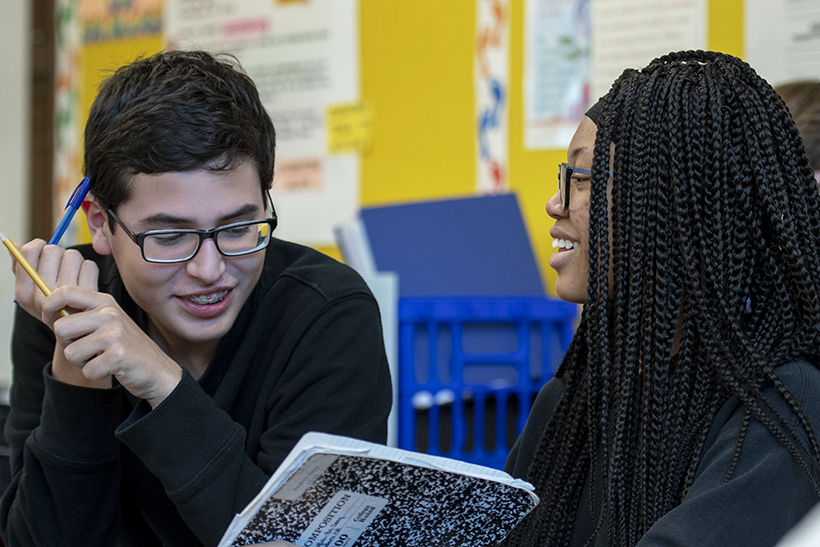This is an excerpt from 360 Degrees of Text: Using Poetry to Teach Close Reading and Powerful Writing (Chapter 2), by Eileen Murphy Buckley. (NCTE, 2011)
Playing with language and sharing important personal experiences are necessary steps in establishing a culture that allows for optimal collaboration in learning.
On the first day, invite students to sit in a circle on the floor. Tell students they will return to this circle throughout their study of poetry, as they collaborate as readers, writers, and performers. Establish this as a special place and, to the extent it is possible, help students overcome aversions to sitting on the floor.
Help students understand that this circle is a place where everyone is equal and everyone can play, make mistakes, and enjoy language. This lesson also serves as a trust-building exercise, which is a critical component of performing, discussing, and writing about poetry.
The first exercise was adapted from an exercise I learned at DePaul University in an NEH-sponsored seminar called “Saying Something Wonderful: Teaching the Pleasures of Poetry.” I have used it with great success with diverse populations of students for years.
In the exercise, students become familiar with the concept of persona by carefully selecting and arranging images to prepare ad hoc stories about themselves. Later you will point out that poets and other writers create personas for their speakers through a similar process of selecting and presenting details.
The subject of this storytelling activity also lays the thematic groundwork for the poem in the sample lesson. However, because the subject has to do with overcoming an obstacle, be prepared for a range of responses from the mundane to the dramatic.
Given the nature of youth and their personal lives, it is also important to contract with them in the same way you would when you assign journal entries, reminding them of your professional obligations and their own obligations as members of a supportive learning community.
Lesson Step 1.1: Sharing a Moment of Overcoming
- Before students enter class for this first lesson, create a display for the term rhetorical situation with this working definition: a context in which there is an act of communication. Helpful graphics of the rhetorical triangle are readily available online. Also create a display of the words that make up the acronym SOAPSTone. (For each rhetorical situation, there is a context as well as a Speaker/ author/communicator, an Occasion for speaking, an Audience, a Purpose, and a Subject that shape the speaker’s Tone.) You can also distribute the SOAPSTone student handout (handout 1.A) and have students keep it in their in-class notebooks. Make these displays permanent for student reference.
- Tell students they will be sharing a one-minute story of a time when they overcame an obstacle. Think, for example, of an accomplishment, facing a fear, finding the right outfit, a spill in aisle four, or the like. The stories can be funny, thought-provoking, surprising—anything students feel comfortable sharing.
- Rather than simply explaining, demonstrate how each person will enter the circle with a physical gesture that evokes an image from the story (for example, throwing a baseball, striking a disco pose, etc.). Explain that once in the center of the circle, the person must wait five beats before speaking. Raise your hand and count five fingers silently. The person in the circle will then tell their story as vividly as possible. When finished, the speaker will wait while you again count five silent beats with your fingers before leaving the circle. As a supportive leader and co-learner, you should demonstrate a telling of your own story as you explain the exercises. Your subject choice and your commitment to full participation in the activity will go a long way toward establish-ing your credibility as a learning leader.
- After one or two minutes of silent, individual brainstorming, ask for a volunteer to begin. When volunteers stop raising their hands, assure the bashful that there is no right or wrong, worthy or unworthy story, simply a recounting of a time of overcoming an obstacle. Then proceed by going clockwise from the last volun-teer until everyone has shared. This is a “mandatory volunteer” process I like. In my experience, even the toughest, most reserved participants cave in eventually.
- After everyone has shared a story, ask students to pair up and share the experience of this storytelling activity using the following questions:
- How was your selection of your subject and its details shaped by concerns about how your audience of peers would perceive you, the speaker?
- How did the gesture focus our attention?
- In a large group debrief, ask a few pairs to share some of the factors that shaped the storytelling experience. Segue to the idea of the rhetorical situation.
After explaining that the students created texts (that is, the stories they shared) in a particular context that shaped what story was selected and which details were shared in which order, let them know that as they explore the rhetorical situation in each of the poems they’ll read, they will learn to begin determining the gist of texts, any text, by identifying key elements of the rhetorical situation, such as audience, purpose or genre, and context.
Refer again to your display of the rhetorical triangle and SOAPSTone questions. Highlight the ways in which student stories were selected and shaped based on the context of their peer audience, and emphasize that one of the key concerns that storytellers had was how the story would shape their audience’s perception of the storyteller’s persona, as a person who is funny, smart, and so on. After all, no one is more conscious of their audience’s perception of their persona than an adolescent.

Read a sample chapter or order 360 Degrees of Text: Using Poetry to Teach Close Reading and Powerful Writing.

